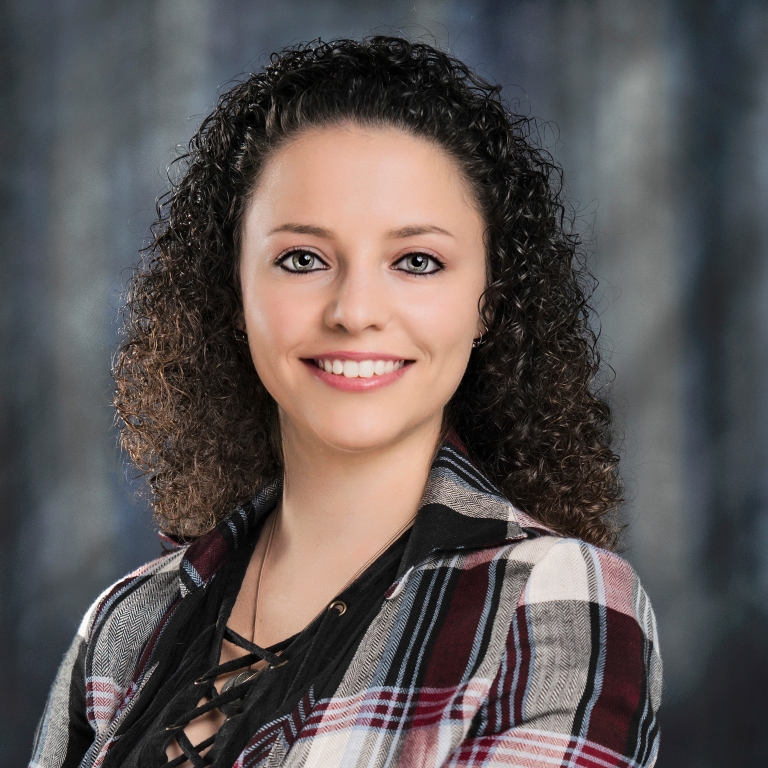
As a young person, Naomi S. Gold was taken by her parents to a performance of “Wicked” in Chicago. It was there that she found her lifelong passion.
“At the time I was fascinated with what I was seeing on stage; I just didn’t quite know what it was yet, but I knew I needed to be involved with it,” Gold said. “I started working tech when I was in sixth grade and never gave it up. Once I got to high school, I started designing lighting, and my passion took off from there.”
Gold, from Aurora, Colorado, is a third-year MFA candidate in lighting design in the Indiana University Department of Theatre, Drama and Contemporary Dance. This semester, she has designed the lighting for “Big Fish,” the second production of IU Theatre’s 2019-20 season.
The production opened Oct. 23 and will resume its run Oct. 30 to Nov. 2 at Ruth N. Halls Theatre in the Lee Norvelle Theatre and Drama Center, 275 N. Jordan Ave. Tickets can be purchased through Ticketmaster; by telephone at 812-855-1103; at the IU Auditorium box office, from 10 a.m. to 5 p.m. Monday to Friday; and at the IU Theatre and Dance box office one hour before the show.

Gold answered questions about her background, her artistry and the show.
Q: What must a lighting designer take into consideration when working on a show?
A: The number one thing would have to be collaboration and learning to listen and understand conversations with the rest of the design team and director. In order to have a cohesive production, we all need to be in tune with one another and work together.
From more of a design aspect, double- and triple-checking your math is very important. Once a fixture is hung in the air, you don’t normally have a lot of time or resources to take it down and move it if it was hung in the wrong location. This is where one’s math becomes extremely important. Do as much pre-planning as you can so that once you get into the theater space, everything works out.
Q: How does a lighting design complement a show’s set design, costume design and other designs?
A: I like to think that lighting helps bring the world of the play or musical to life. The set visually tells us where we are, the costumes tell us what time period and who the people are, but the lighting creates an atmosphere that makes us feel that we, the audience, and the cast are physically inside the world that scenic and costumes has created for us. Each design area, once combined together, brings to life what the playwright wrote on paper.
Q: Your lighting design for “Big Fish” is your MFA thesis. What challenges or opportunities did the show provide?
A: “Big Fish” is a larger than life story; it has mythical proportions. It creates a dialogue of three different through lines that we – the design team and cast – must be able to portray: present day, with Edward and his son, Will, as adults; the past, with Edward and his young son, Will; and the distant past, with Edward before he meets his wife, Sandra, and before Will is born. And throughout all of this, there is the magic of fantasy that is intertwined in each of these three time periods.
It can be a challenge keeping track of what time period we’re in and whether we’re rooted in fantasy or reality. But this can also be seen as a great opportunity because it gives me the ability to create my own dialogue to help tell the audience where we are in the story. For example, when we’re in the distant past before Edward marries, there is no front diagonal light in the lighting design. This helps to create a different feeling on the stage due to the different usage of angles of light versus the recent past and the present, which use front diagonal light. Another example is that when we’re in fantasy, there is a lot more saturated color and pattern used on the stage.
Q: What about the lighting might audience members want to take special notice of for “Big Fish”?
A: I believe that lighting shouldn’t fully be noticed when watching a performance. If someone notices something specific, then maybe I did something wrong. Lighting is a device used to further the storytelling of a play, not be a character of its own. Maybe an audience could take into account how the lighting has been used to help create the atmosphere of the world and how it is used to help with the storytelling.
Q: How have you evolved as an artist and person during your tenure in the Department of Theatre, Drama and Contemporary Dance?
A: As an artist I have learned to understand color in light a lot more: knowing what colors mix well together and which ones do not, and also about the absence of color; how shadows play into the world as the absence of light; or using color, a deep blue or purple for example, to create a shadow instead. I have also become much more organized, especially with my paperwork. The better organized the paperwork, the easier it is to relay my design to the technicians who will be prepping all of the equipment for the production.

